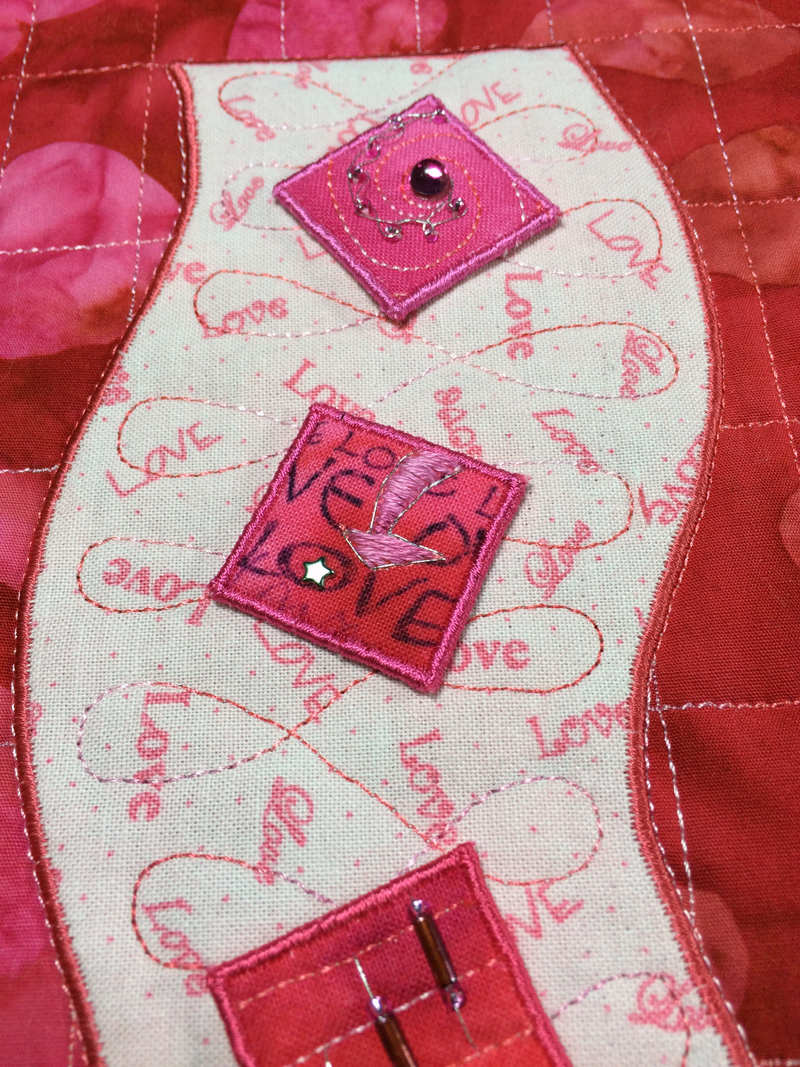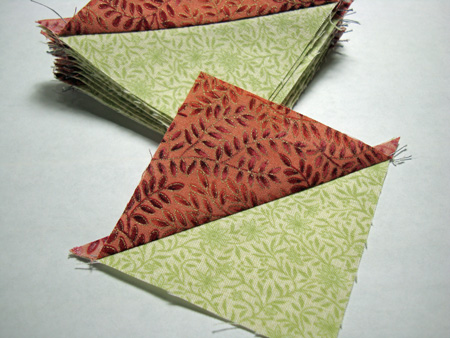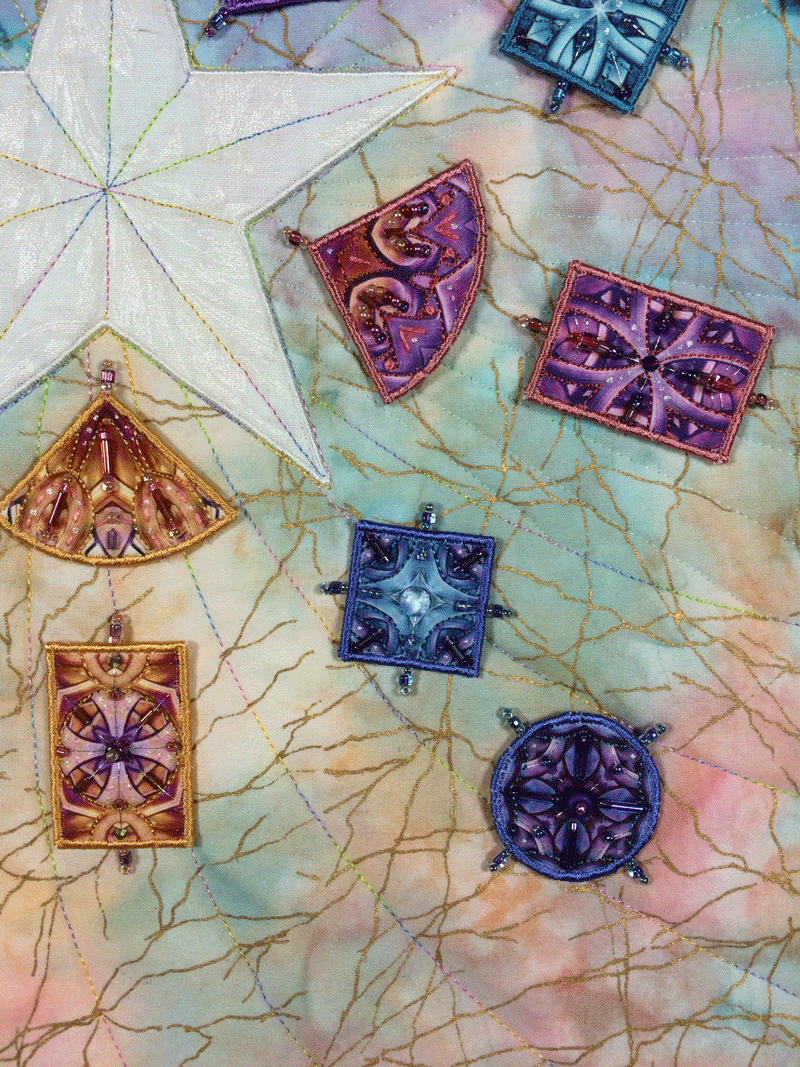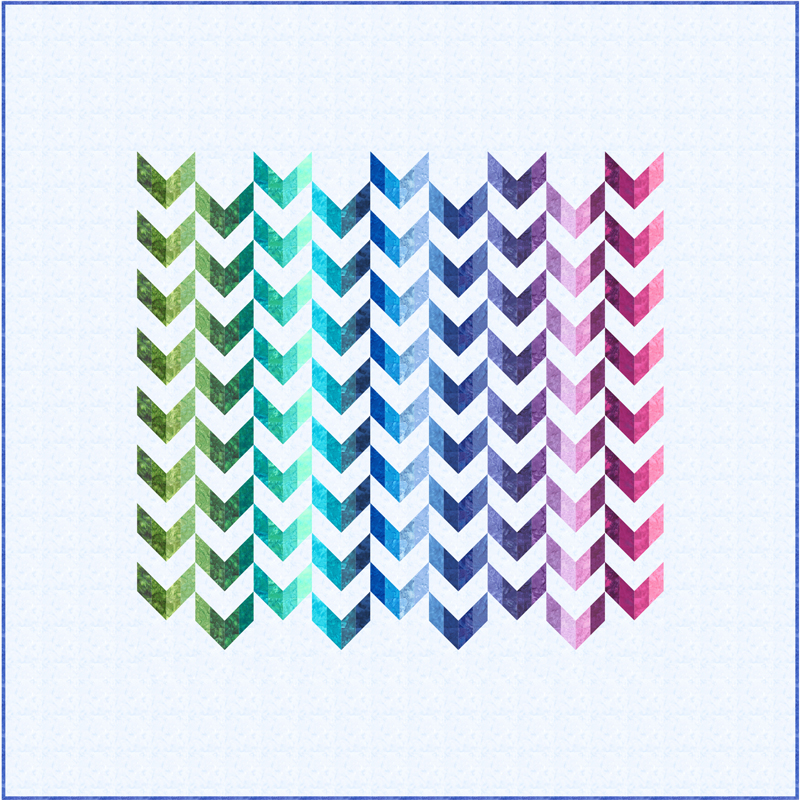Years ago, I purchased an interesting little computer program at Quilt Market. Kaleidoscope Kreator™ does just what it says–it makes kaleidoscopic designs from photos, clip art, or drawings, which you can then print directly on fabric or paper. Alternatively, you can export the images to edit, adjust color and/or further customize in a graphics program. Sweet, right? Continue reading
Patterns
Bali Pops Precuts and Bali Breezes Quilt Pattern
Years ago, I had a quilt plan in my head that called for a LOT of different fabrics. I thought that the best/easiest way to get the fabric variety I needed would be to use precut strips, and I purchased a bunch of different Hoffman Bali Pops from the Fat Quarter Shop, and found one “locally” at the Army Arts and Crafts shop in Germany. If you’ve been around a while, you may remember this post, in which Crazy Accuracy Freak Girl had conniptions over the state of those precut strips. They were crooked and cut off grain, and I couldn’t see how you could use those strips for anything that required any accuracy at all.
I heard from both Hoffman and Fat Quarter Shop about that blog post, and there were offers to replace and/or refund the costs of the bundles which was lovely of them obviously. I never bothered with that since I’d have had to mail them back to the States from Germany, and I didn’t plan on using them right then in the end anyway.
Fast forward to December of last year. The folks at Hoffman Fabrics wrote to tell me that the Bali Pops are now cut with a laser-guided fabric cutter, and they asked if I’d like to try the new strips in a project. I chose the Hoffman Bali Pops in the Gemstone colorway, and got to work designing! Continue reading

New Inchie Quilt! Where the Inchies Are Remake
0
I’m totally excited about my latest finish! It’s a fun little quilt that I made for Valentine’s Day, and also just because! Just because I had some red and pink scraps laying around, and just because I wanted a quick-to-make project with Inchies. If you follow on Instagram, you’ve seen some sneak peeks already, but now I have some larger pics of the quilt and of course, the addicting little Inchies. Continue reading
A Touch o’ the Irish–Quilting, that is!
6
I’ve been a bit behind on the blogging lately. I have all these pictures that I’ve taken, and things stored up in the back of my head to blog about, and then life gets in the way, and the stuff never makes it to the keyboard and thence to the screen. One of the most exciting things happened at the beginning of June:

One of my Inchie Quilts called Where the Inchies Are appeared in Irish Quilting Magazine! Cool, right? Now take a look at the picture of the quilt in the magazine: Continue reading

HSTs & QSTs: It’s Not You, It’s the Math
20
Have you ever wondered why points are so difficult to match up when you’re making a block with half-square or quarter-square triangles? It’s not so bad if the entire block is HST’s or QST’s by themselves (except that the block will most likely not finish to exactly the expected size), but pair either one with squares or rectangles and expect the corners and points to match up and everything to be sized right in the end, and you’re likely to be disappointed, no matter how carefully you’ve sewn or how accurate your 1/4″ seam allowance is.

Well, I’ve got a news flash for you: it’s not you or your sewing skills, it’s the math. And I don’t mean that you or the pattern designer have miscalculated the cutting sizes either. What I mean is that mathematically, when you calculate the size of square to cut for a certain finished size of half-square or quarter-square triangle, you won’t get a size that’s rotary cutter friendly. It’s some algebraic formula like Asquared+Bsquared=Csquaredyaddayadda, and I did actually do the math a couple of years back though I don’t remember the formula at the moment.
This whole issue can be proven with graph paper as well. Try this: draw HST#1 with 2″ straight sides on graph paper, and then add 1/4″ seam allowances all the way around. Then draw HST#2 at the universally accepted cut size, with 2 7/8″ straight sides (the formula to determine the cut size for a HST is finished size + 7/8″). Measure the straight sides on the HST#1, which should be 2 7/8″, but they’re not. Sure, it’s not THAT far off, but when a block contains 8 or 16 HST’s, or when those HST’s are supposed to fit together with a 2 1/2″ square patch, this can cause issues down the road.
The bias edge across the middle of the HST adds its own measure of instability and inaccuracy, and it all equals wonkyness that’s not likely to be the right size in the end. What to do? I’ve gotten to the point where I cut large and trim down after the HST’s or QST’s are sewn, so that I know I’m getting the right size and everything is really square. I use the formula, then add 1/2″ or 3/4″ to the squares when I cut them. I dislike doing this for two reasons: one, it’s an extra step, and in multiples no less, since how many quilts need just one or two HST’s or QST’s, and two, it’s a fabric waster which is really not okay. There is a silver lining though (see, I can find one in this morass!): when you trim the HST’s or QST’s down to size, you’re trimming away the “dog ears” at the same time, so that’s a bonus.
Some patterns these days may just tell you to do that from the beginning, cut large and trim to the right size after piecing, but I’m basing all this on my personal experience with patterns and books, which is probably old since I don’t generally buy patterns or make quilts out of books anymore, preferring to tumble over the cliff of my own creativity into the scrappy mess of UFO’s and failed fabric experiments at the bottom. When I was buying books and patterns a few years ago, patterns were written based on cutting the “exact” size you need, and expecting the HST’s and QST’s to be the right size in the end and they never were, and the edges were curvy and wonky in the bargain.
So what’s your solution to the HST and QST finished size/cutting size quandary? Do you have these issues with patterns these days? Do you cut bigger and trim, or just deal with the fallout on the fly when piecing blocks?
Edit: Crazy Accuracy Freak Girl wrote this while I was having breakfast. 😉 I try to keep her penned up and away from the blog, but sometimes she sneaks out and adds her two cents…or two dollars, as the case may be. Thanks for putting up with her.—Nadine
Copyright law and the quilter
6

I’ve been mulling over the issues of copyright as it relates to quilting in my mind lately. In recent years, there have been some pretty loud rumblings in the quilt world about this issue, as more and more quilters, artists, designers and companies become aware of the law. To me, most of the interpretation of copyright law has been pretty self explanatory and logical really, at least for my purposes. It’s the oft repeated “do unto others as you would have them do unto you” thing. When you purchase a quilt pattern or book you’ve purchased the right to make that project for personal use, or as gifts. Selling the project is generally not allowed, though in some cases, designers have expressly granted permission to make a certain number of projects to sell (sometimes up to ten) for profit at craft fairs and shows.
All that being said, I really feel that if I have made a quilt from a pattern in a book, and I want to sell that quilt, I should be able give credit to the designer and price the work accordingly, taking into account only the time and materials I put into the project. In other words, I would be charging for my time and materials, not for the originality of the design itself. If I sell a quilt that is my own design, I would charge for my time, the materials, and for the originality of the design as well. I would happily grant that privilege to anyone who purchased one of my patterns as well. That is not what the law says, though, so that’s not what we are allowed to do.
Recently I’ve seen more and more questions and issues about showing quilts made from commercial copyrighted patterns. This is where it gets sticky and mean sometimes, I think, Continue reading



